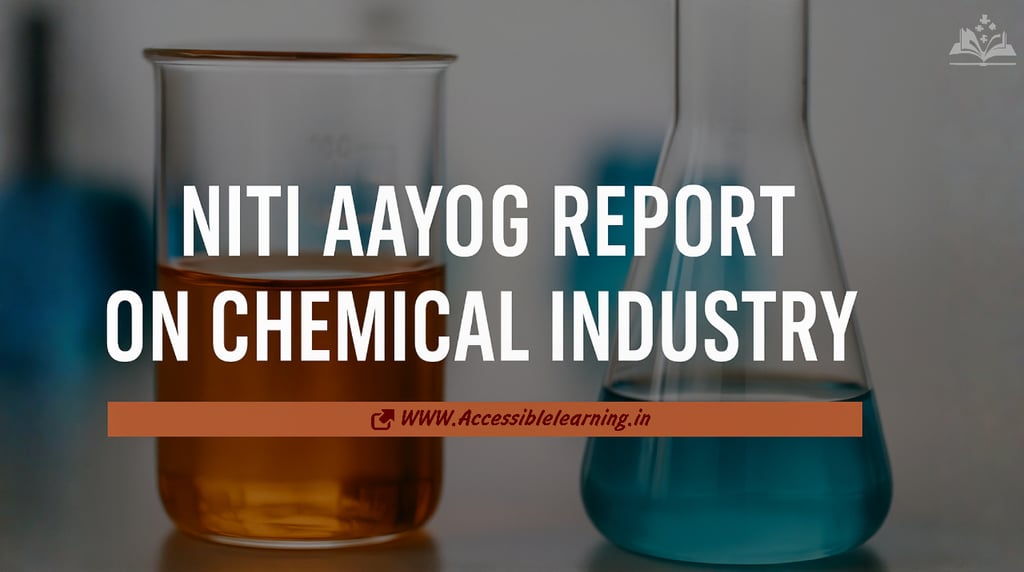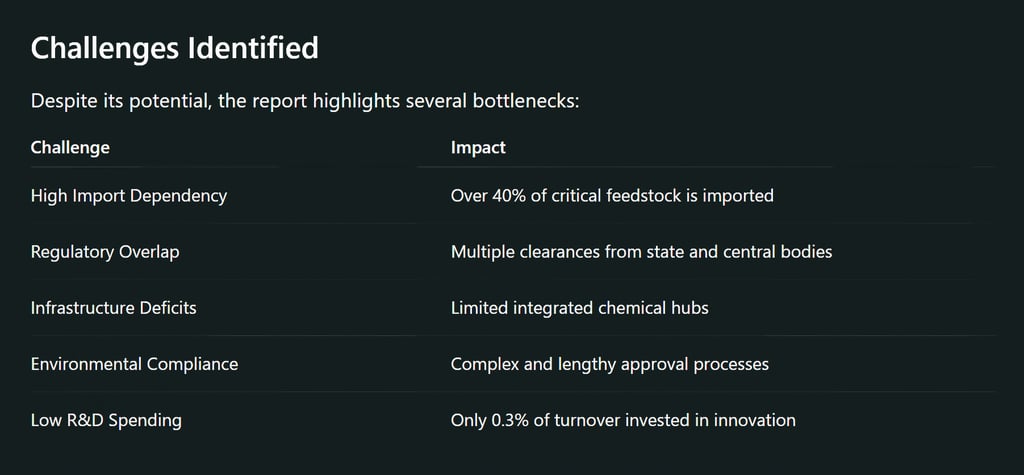
NITI Aayog Report on Chemical Industry: A Strategic Vision for India’s Growth
Discover the key insights from the NITI Aayog’s strategic report on India’s chemical industry. Learn about growth opportunities, policy reforms, green chemistry, infrastructure development, and India's roadmap to becoming a global chemical manufacturing leader.
NEWS/CURRENT AFFAIRSSPACE/TECHEDUCATION/KNOWLEDGE
Keshav Jha
7/11/20255 min read


India’s chemical industry is at the heart of its economic transformation, with far-reaching implications for sectors such as agriculture, textiles, pharmaceuticals, and infrastructure. Recognizing its significance, NITI Aayog, the government’s premier policy think tank, released a comprehensive report titled “India’s Chemical Industry: A Sectoral Strategy for Aatmanirbhar Bharat.” This strategic document lays out a detailed roadmap to unlock the sector’s growth potential, positioning India as a leading global player.
Why the Chemical Industry Matters
The Indian chemical sector is the 6th largest in the world and the 3rd largest in Asia, contributing over 7% to India’s GDP. It supports over 2 million jobs and has a direct role in nearly 80,000 products, from life-saving drugs to sustainable packaging.
Exports: Over $44 billion (FY2022-23), with significant contributions from specialty chemicals.
Consumption Growth: Expected to reach $300 billion by 2025.
Key Linkages: Supports agriculture (fertilizers), health (pharma intermediates), automotive, textiles, and electronics.
Key Highlights from the NITI Aayog Report
Vision for Self-Reliance
NITI Aayog envisions turning India into a chemical manufacturing powerhouse under the Aatmanirbhar Bharat mission. The report outlines policy recommendations to reduce import dependency, especially in petrochemicals and specialty chemicals.
Focus on Specialty Chemicals
India has a competitive advantage in specialty chemicals, driven by low-cost manufacturing and skilled talent. The report suggests
Creating chemical clusters
Encouraging R&D investments
Promoting technology transfer partnerships
Building Chemical Parks
To boost infrastructure, the report calls for
Plug-and-play chemical parks with common utilities
Easier land acquisition policies
Green zones with environmental clearances streamlined
Sustainability & Circular Economy
A major focus is on transitioning to green chemistry, minimizing hazardous waste, and promoting bio-based alternatives. NITI Aayog also stresses:
Adoption of waste-to-value technologies
Carbon capture in production processes
Water recycling and energy efficiency
Skilling & Workforce Development
With rising automation, the industry will require a future-ready workforce. The report emphasizes
Collaboration with ITIs, universities, and private players
Industry-specific skill development missions
Digital training in areas like AI, robotics, and process automation
Ease of Doing Business
NITI Aayog recommends:
Simplifying environmental compliance
Fast-tracking Single Window Clearances
Creating a National Chemical Policy Framework to unify fragmented regulations




Global Geopolitical Shifts Boosting India’s Role
China+1 Strategy: With rising costs and stricter regulations in China, global players are actively shifting supply chains to India. This has accelerated foreign direct investments (FDIs) into India’s chemical zones.
Russia-Ukraine War: This disrupted the global supply of fertilizers and feedstocks, leading to India's increased strategic importance in agrochemical exports.
Emerging Sub-Sectors with High Growth Potential
Green Hydrogen & Chemicals
India aims to become a hub for green hydrogen-based chemicals, particularly green ammonia and methanol, used in fuels and fertilizers.
NITI Aayog sees this as a key vertical under energy transition commitments.
Biochemicals & Bio-based Alternatives
The rise of bio-based solvents, polymers, and surfactants is a focus area.
These are aligned with EU REACH compliance, boosting India’s export compatibility.
Electronic Chemicals
With India's push in semiconductor manufacturing, demand for ultra-pure chemicals like photoresists, etchants, and high-purity gases is rising.
The report indirectly supports these by calling for investment in precision manufacturing facilities.
Role of Digital Technologies
While traditional chemical manufacturing is process-heavy, there's a growing shift toward
Digital twins for plant operations
Predictive maintenance using AI
Blockchain in chemical logistics and safety tracking
NITI Aayog proposes R&D incubation support to adopt such digital transformations in chemical SMEs.
India’s Role in Global Sustainability Goals
As per the UN’s Sustainable Development Goals (SDGs), chemicals are central to clean water, clean energy, and sustainable cities.
India’s commitment to carbon neutrality by 2070 will rely heavily on green chemistry adoption, as stressed in the report.
Strategic International Collaborations
Several bilateral and multilateral initiatives support India’s chemical growth:
India-EU Trade & Tech Council: Negotiating smoother chemical exports via mutual recognition of regulations.
Japan’s investments in Indian chemical parks for specialty chemicals and lithium-ion battery supply chains.
India-UAE CEPA Agreement: Eases export of chemicals to the Gulf and North Africa.
State-wise Industrial Policy Support
The central government is working with state governments to align policies. Key moves include
Gujarat, Maharashtra, and Tamil Nadu offer dedicated chemical SEZs and tax subsidies.
Andhra Pradesh & Odisha are emerging with new coastal chemical corridors for import-export optimization.
ESG (Environmental, Social, Governance) Mandates
Many global buyers now demand ESG compliance in their chemical sourcing. India is promoting
Renewable energy usage in chemical production
Social compliance audits (worker safety, wages, waste handling)
Insurance, Safety & Disaster Management Reforms
Following recent industrial accidents (e.g., the Visakhapatnam gas leak), the report hints at
A national-level Chemical Safety Code
Mandatory environmental liability insurance for all large units
Digitization of Material Safety Data Sheets (MSDS)
Financing Mechanisms
NITI Aayog recommends working with
SIDBI & Exim Bank for low-interest loans for green chemical startups
Launch of a Chemical Venture Fund (CVF) to incubate early-stage chemical innovation firms
Human-Centric Development Goals
To ensure equitable development, the report suggests
Establishing gender inclusion policies in chemical industry hiring
Special training for rural youth and women in chemical handling and lab operations
Promoting safety literacy among plant workers and nearby communities


NITI Aayog’s Strategic Recommendations
Policy & Regulatory Reforms
Introduce National Chemical Development Council for cohesive planning
Establish a unified Chemical Management Authority
Launch PLI (Production Linked Incentive) schemes for R&D
Infrastructure & Innovation
Accelerate PCPIR (Petroleum, Chemicals, and Petrochemicals Investment Region) development
Create Chemical Innovation Centers in partnership with academia and industry
Investment & Export Promotion
Tax benefits and capital subsidies for exporters
Build chemical-specific SEZs
Strategic FTA alignments for market access
Global Context: India vs. China
With China tightening environmental regulations and witnessing rising labor costs, global manufacturers are looking at India as a viable alternative. NITI Aayog believes India can emerge as the next China in chemical manufacturing, especially in
Agrochemicals
Colorants
Pharma intermediates
Surfactants
Future Outlook
If recommendations are implemented effectively, India’s chemical industry could:
Reach $1 trillion valuation by 2040
Create 10 million+ jobs
Rank among the top 3 global producers
FAQs
Q: What is the core focus of NITI Aayog's report?
The report focuses on boosting self-reliance, scaling up manufacturing capacity, reducing imports, promoting R&D, and improving ease of doing business in the chemical sector.
Q: Which segment is India most competitive in?
India holds a strong position in specialty chemicals, including dyes, pigments, pharma intermediates, and agrochemicals.
Q: What are the infrastructure initiatives recommended?
NITI Aayog suggests developing integrated chemical parks, modernizing logistics, and enhancing power, water, and waste management utilities.
Q: Is the report aligned with environmental goals?
Yes. A significant section is dedicated to green chemistry, sustainability, and circular economy models to ensure low-carbon, eco-friendly growth.
Q: How will the report impact MSMEs?
The report promotes MSMEs through cluster-based development, shared infrastructure, and access to finance and technology.
The NITI Aayog report on the chemical industry is more than a policy document—it’s a strategic blueprint for India’s industrial future. By aligning growth with sustainability, innovation, and global competitiveness, India can not only meet domestic demands but also lead the world in next-generation chemical manufacturing. With timely implementation, the vision of a green, self-reliant, and globally recognized Indian chemical sector is well within reach.
Subscribe to our newsletter
All © Copyright reserved by Accessible-Learning
| Terms & Conditions
Knowledge is power. Learn with Us. 📚


